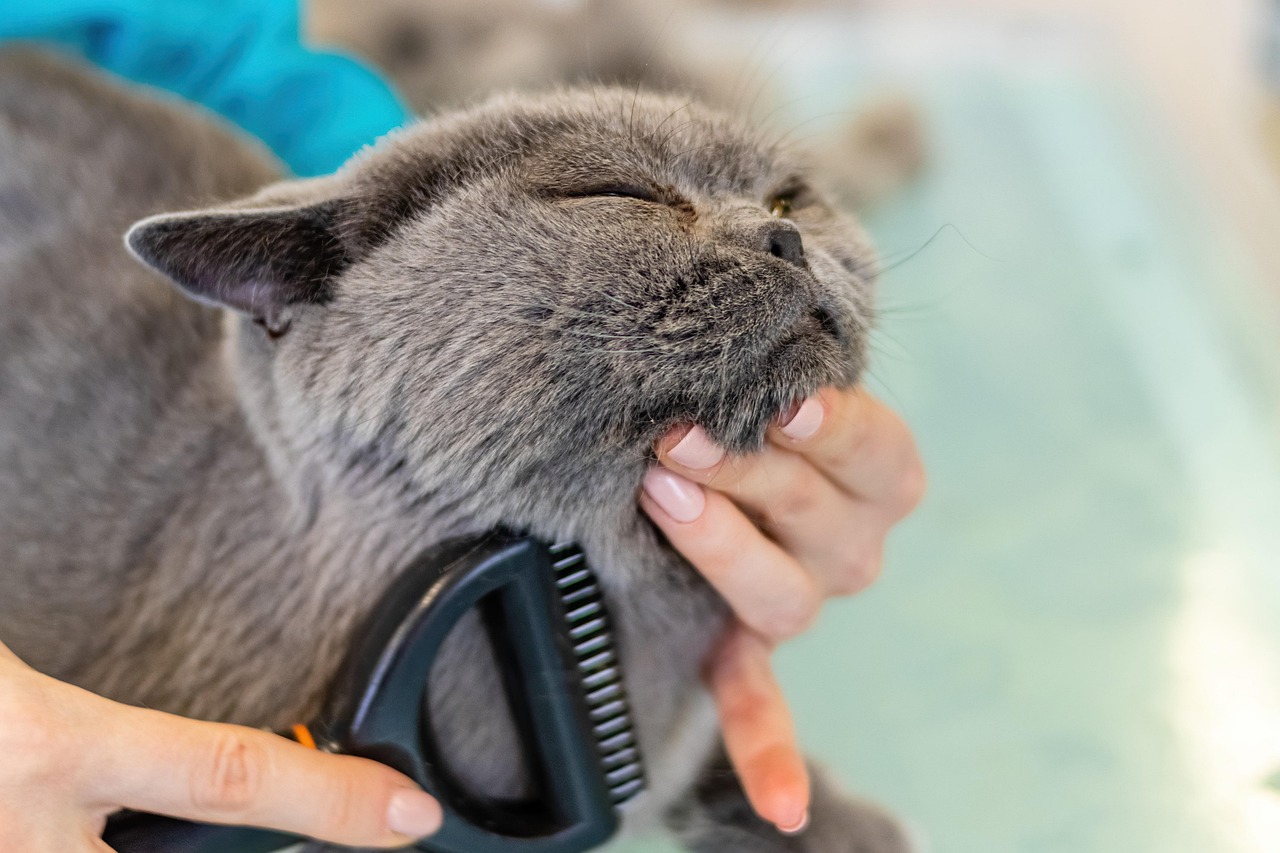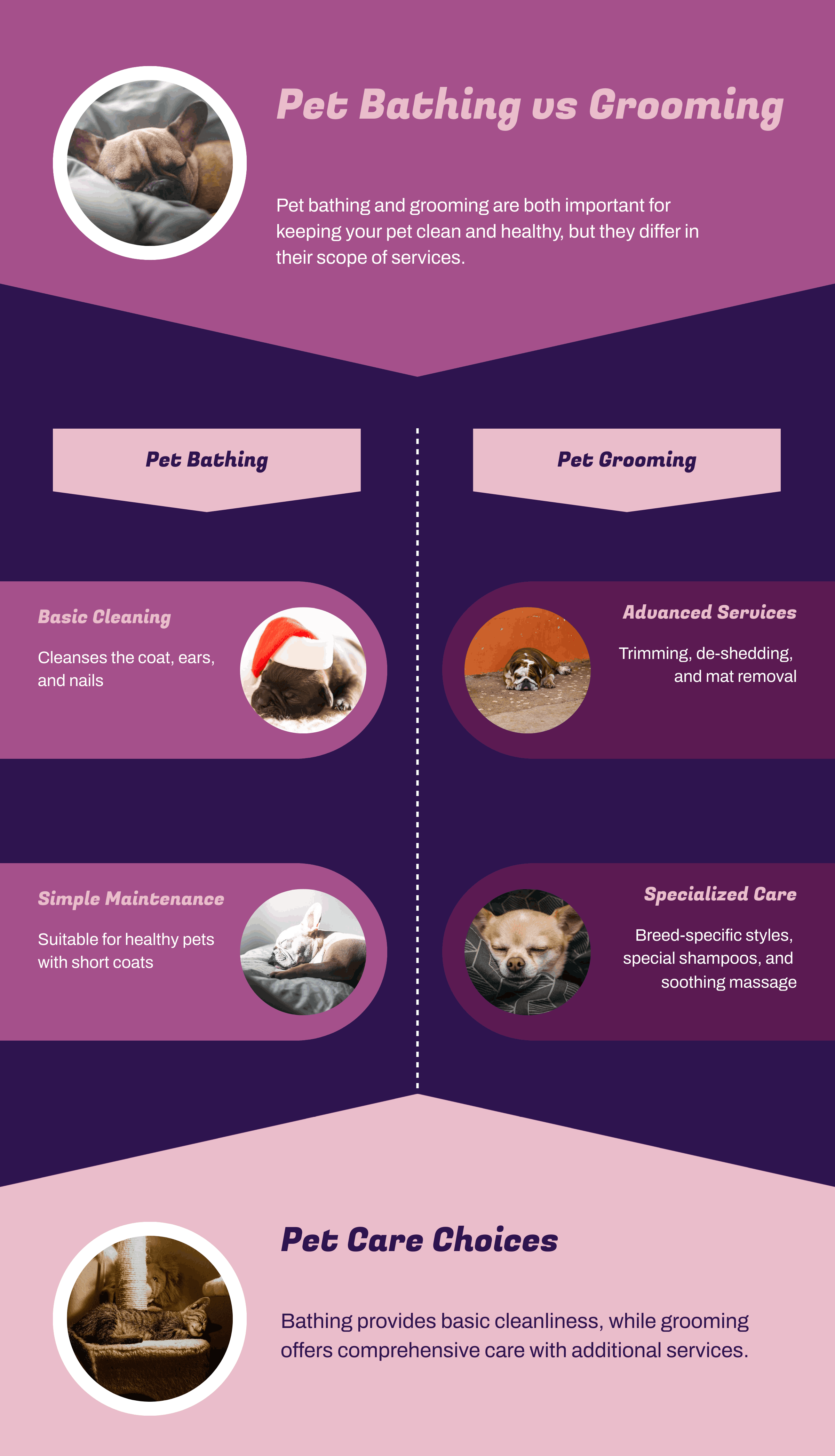An animal that spends most of its time roaming outside gets dirty, and smelly and may bring fleas, ticks, or infections into the home. A proper bath helps keep them clean and safe.
Some believe bathing daily is necessary, but that’s a misconception. The answer depends on many factors like coat type, lifestyle, and time of year. For example, a dog in rainy weather may need baths more often.
Grooming is an important aspect of pet well-being and includes wiping paws, brushing, nail trims, ear cleaning, blow-dry, haircuts, and anal gland expression. It also helps identify underlying diseases early.

Pet Bathing and Grooming – Here’s How to Make a Healthy, Happy Pet
Pet bathing and grooming keep pets clean, healthy, and comfortable by preventing odors, infections, and shedding. Bathing removes dirt, while grooming includes brushing, trimming, and ear cleaning.
The frequency depends on breed, coat type, and lifestyle. Regular grooming strengthens bonds, improves hygiene, and ensures early health issue detection. Professional groomers offer specialized care for better results.
What’s the Difference Between Pet Bathing and Grooming?
A bath keeps your pet fresh by cleaning its coat, ears, and nails, but grooming takes it further. Professional groomers provide extra services, like trimming and de-shedding to remove loose fur from the undercoat.
If your pet is suffering from matting or staining, a groomer has the ability to cut, trim, or even shave the affected areas for relief.
Some breeds of cats and dogs have standard styles that help identify them, and only skilled groomers can get it right. Special shampoos, soothing massage, and pleasant scents make the experience even better while reducing the shed and decreasing fur buildup at home.

Importance of Pet Bathing and Grooming (7 Benefits)
Regular pet bathing and grooming are essential for maintaining health, hygiene, and overall well-being, ensuring a clean, comfortable, and happy life for your pet. Here’s why:
Keeps the Coat Clean and Healthy
Brushing your pet daily or every few days helps remove dirt, loose hair, and dead skin cells. It also prevents mats and clumps, keeping the coat glossy and tangle-free. A well-maintained coat acts as a barrier against rashes and infections.
Prevents Flea Infestations and Parasites
Regular grooming sessions provide an opportunity to spot small signs of infestations. If your pet is infested, you may notice reddened skin, tiny red bites, hair loss, or a collection of brown flea dirt on the base of the tail, abdomen, neck, or ears.
Early Detection of Health Issues
When you brush, you can look for rashes, hot spots, lumps, and bald spots. If you notice any symptoms, a veterinarian can give advice on potential health concerns. Regular bathing and grooming help discover problems before they become uncomfortable.
Improves Hygiene and Odor Control
Bathing is essential for maintaining good hygiene and eliminating unpleasant smells. Using special shampoos, a professional groomer can remove excess dander and dirt, leaving the pet fresh and clean. Regular bathing also lowers allergens, helping allergic owners breathe easier.
Helps with Trimming Claws and Mobility
Overgrown nails affect a pet’s ability to walk and run, sometimes leading to ingrown claws. Trimming prevents misaligned pads, which can cause joint pain in dogs and cats. If cat’s nails get too long, they may curl and trap germs, increasing the risk of infections.
Strengthens the Bond Between Owner and Pet
Grooming sessions build trust and companionship, making your pet feel relaxed. Positive reinforcement during brushing and bathing improves mental health and behavior. A smelling good, looking neat pet enjoys more social opportunities with family.
Helps Prevent Shedding and Allergies
Certain breeds are heavy shedders, and regular brushing and bathing can loosen excess fur before it spreads on the floor. This reduces allergies and keeps the home clean. Conditioners can also lower the amount of shed hair, reducing the need to vacuum constantly.
How Often Should You Bathe Your Pet?
Keeping your pet clean is important, but bathing too often can cause dry skin. The best schedule depends on your pet’s breed, coat type, and lifestyle. Some breeds have oily coats that may need monthly baths, while short-haired dog or cat stay cleaner longer. If your furry friend loves rolling in mud or swimming in the ocean or a lake, more frequent baths may be needed.
A veterinarian can help determine the optimal time for your pet’s bathing routine, especially if they have a skin condition. Double-coated and water-repellant breeds may only need baths every few months to prevent dryness. Hairless breeds, like the Xoloitzcuintli, require weekly baths with a moisturizing shampoo to protect against infections. Brushing regularly helps remove dirt, debris, and bacteria between washes.
Grooming is more than just a full bath. A regular routine should include:
- Trimming toenails to prevent discomfort
- Brushing to remove snags and tangles
- Using de-shedding tools for thicker coats
- Cleaning ears and skin folds to avoid irritating buildup
Seasonality also affects bathing needs. In summer, dog odor worsens due to greasy coats, allergies, and parasites like fleas and ticks. In winter, domestic animals are less dirty, but their skin may become dry, requiring a moisturizing shampoo. A wet washcloth can help with spot cleaning instead of frequent baths.
Age and lifestyle play a role too. Puppies and kittens are more active and may need more baths, while senior dogs and cats tend to be inactive and may require intensive care, especially if dealing with incontinence. Grooming wipes are great for keeping them fresh without over-washing.
What Should be Included Pet Bathing and Grooming Session?
Grooming keeps your pet both clean and healthy, offering many benefits beyond just looking and smelling fresh. A good session includes brushing the coat to remove damaged and old hair, helping new growth. Professional handling helps detect bumps, lumps, or irritations, making sure any issue is caught early.
A proper bathing routine includes shampoos that are gentle, non-toxic, and safe for pets with sensitivity or allergy concerns. Professional groomers ensure thorough cleaning, especially if a pet gets muddy or even skunked. They also handle tough tasks like:
- Trimming, shaving, and clipping unwanted hairs
- Using special scissors and clippers suited for different breeds
- Checking for ticks, fleas, and other pests
Pet parents who take their pets to a groomer regularly avoid heavy-duty hitting when dealing with tight knots or pets that have rolled in sticky substances like bubblegum. These tasks are best left to experts with special tools to deal with the situation safely. A well-done groom improves posture, movement, and overall health, making it easier for pets to run with ease while reducing the risk of injury.
7 Tips to Give Your Pet a Proper Bath
Many pets dread bath time, but the right tips can make the process easier. A gentle approach and good preparation help keep them comfortable while keeping their skin and fur clean.
- Don’t overfill the bathtub! Just a few inches of lukewarm water is ideal for small or medium pets. Too much water can feel overwhelming.
- Brush before the bath to remove dirt, prevent mats, and make detangling wet fur easier. This keeps the bath short and stress-free.
- Be prepared with supplies to avoid interruptions. Having shampoo, a towel, and other grooming tools ready reduces stress for both you and your pet.
- Provide sure footing by placing a non-slip rubber mat or a towel at the bottom of the tub. This prevents sliding on the slippery surface.
- Use only pet-safe shampoo! Human shampoo is too acidic and may contain fragrances that are unappealing or irritating, leading to dry skin or even an infection.
- Check dog-safe products online, at pet supply stores, or ask your veterinarian for recommendations. The right shampoo helps increase protection against skin issues.
- Consider a professional groomer if the bath is an unpleasant experience. Scheduling an appointment makes the process easier, especially for nervous pets.
Final Words
- Regular pet bathing and grooming keeps your pet clean, healthy, and comfortable while reducing odors and skin problems.
- A good routine includes bathing, brushing, trimming, and ear cleaning to prevent shedding, infections, and mobility issues.
- Whether done at home or by a professional groomer, proper care ensures a happy, fresh-smelling pet that enjoys better well-being.
FAQs
What is bathing and grooming?
A bath keeps a pet’s coat clean, while grooming includes trimming, nails, and ears care. These tasks go a long way, offering traditional and extra services to pamper pets and ensure good hygiene.
What does pet grooming mean?
Pet grooming involves trimming, shaving, and clipping the coat when necessary, using scissors, clippers, and other special tools. Professional groomers have extensive knowledge about different dog breeds and know how to remove unwanted hair properly.
What is the purpose of grooming a pet?
Regular grooming and brushing keep a pet’s coat healthy and significantly improve comfort. It helps reinforce your bond, while reducing mats in the fur, which, if untreated, may cause abrasions, ulcers, pain, and discomfort.
What are the 7 steps of grooming a dog?
Start by brushing your dog regularly, as it is the key to keeping the coat clean and tangle-free. Give more frequent baths, keep an eye out for spring shedding, clip nails with the right equipment, and cut hair properly. Dogs use deodorant, too, so check paws for hygiene.

